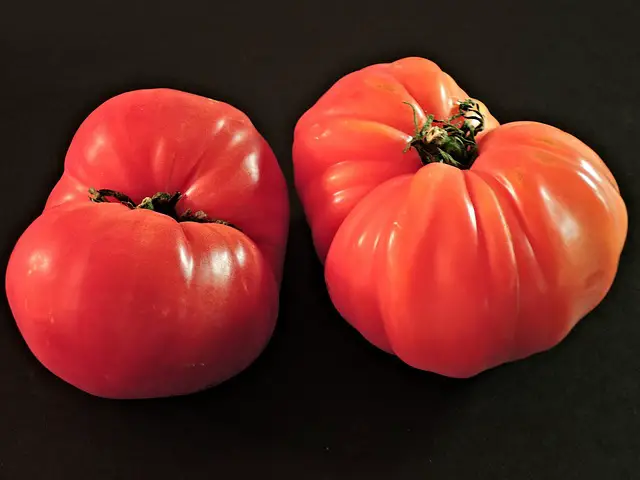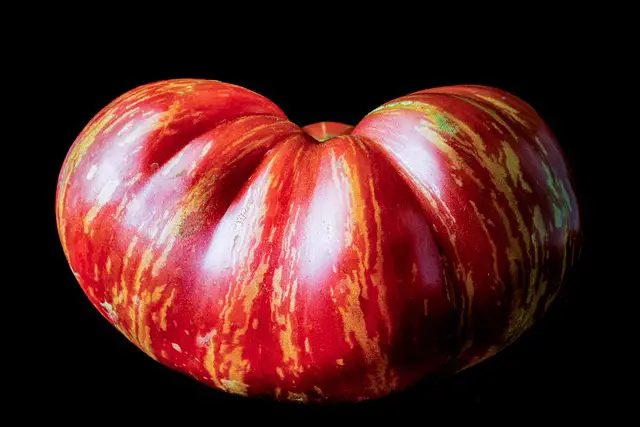Heirloom tomatoes come in a wide variety of shapes, sizes and colors, which makes them an exciting addition to any meal. Though they may require a little more special care than regular tomatoes – such as checking for blemishes or rot before purchasing – the unique flavor heirlooms offer are typically worth the extra effort.
What are Heirloom Tomatoes?
(Image by pixel1 from Pixabay )

There are many different types of tomatoes, but heirloom tomatoes are a specific type of tomato that is grown for its unique flavor. Heirloom tomatoes are not the same as regular tomatoes, and there are several key differences between the two.
Heirloom tomatoes are usually much more flavorful than regular tomatoes. They often have a complex, rich flavor that is unlike any other type of tomato. Heirloom tomatoes are also generally much more expensive than regular tomatoes, due to their rarity and unique flavor.
Another key difference between heirloom tomatoes and regular tomatoes is their appearance. Heirloom tomatoes often have a more irregular shape than regular tomatoes, and they come in a wide variety of colors. Regular tomatoes are typically red or green, while heirloom tomatoes can be yellow, orange, pink, or even purple.
Heirloom tomatoes are typically grown in small batches by farmers who specialize in growing them. This allows for better control over the quality of the fruit. Heirloom tomato plants are also often grown using organic methods, which further contributes to their superior flavor.
The Difference between Heirloom and Regular Tomatoes
There are many differences between heirloom and regular tomatoes, but the most notable difference is their appearance. Heirloom tomatoes are often more colorful and have a more unique shape than regular tomatoes. They also tend to be more flavorful and fragrant.
Another major difference between these two types of tomatoes is their history. Heirloom tomatoes are open-pollinated, meaning that they can be grown from seed that has been passed down for generations. Regular tomatoes, on the other hand, are usually hybrids that have been created by cross-breeding different varieties of tomato plants.
If you’re looking for a truly unique tomato experience, then heirloom tomatoes are the way to go. However, if you’re looking for a dependable and disease-resistant plant, then regular tomatoes may be a better choice.
Heirloom Tomato Recipes
(Photo by Roland Suciu on Unsplash )

If you’re lucky enough to have heirloom tomatoes growing in your garden, or if you’ve found them at your local farmers market, then you know how delicious they can be. But what do you do with them? Here are some of our favorite heirloom tomato recipes:
Heirloom Tomato Salad: This simple salad is perfect for showing off the flavor of heirloom tomatoes. Just slice them up and toss with some fresh basil, olive oil, and a little vinegar. Add salt and pepper to taste.
Heirloom Tomato Sauce: This sauce is great on pasta, pizza, or anywhere else you would use a tomato sauce. To make it, just cook down some chopped heirloom tomatoes with garlic, olive oil, and your favorite herbs. Season to taste with salt and pepper.
Grilled Heirloom Tomatoes: These are amazing on the grill! Just slice the tomatoes in half lengthwise and brush with olive oil. Grill over medium heat until they are slightly charred. Sprinkle with salt and pepper and enjoy!
How to Grow Heirloom Tomatoes
Heirloom tomatoes are varieties of tomatoes that have been passed down through generations and have unique flavor profiles and appearances. Growing heirloom tomatoes can be a rewarding experience as they often have better taste and texture than commercially grown tomatoes. Here are some steps on how to grow heirloom tomatoes:
- Choose the right variety: There are many different varieties of heirloom tomatoes, each with its unique characteristics. Some popular varieties include Brandywine, Cherokee Purple, and Black Krim. When choosing a variety, consider the climate and growing conditions in your area, as well as the flavor profile and appearance of the tomato.
- Start from seed: Heirloom tomatoes are typically grown from seed. You can purchase seeds from a reputable seed company or save seeds from a ripe tomato from the previous season. Start the seeds indoors about six to eight weeks before the last frost date in your area. Plant the seeds in seed starting mix and keep them in a warm, sunny location.
- Transplant to a larger container: When the seedlings have grown their first true leaves, transplant them into larger containers filled with potting mix. Keep the plants in a warm, sunny location and water them regularly.
- Harden off the plants: About two weeks before transplanting the plants into the garden, start hardening them off by gradually exposing them to outdoor conditions. Start by placing them outside for a few hours each day and gradually increase the time and exposure to sunlight.
- Plant in the garden: When the plants are about six to eight inches tall and the danger of frost has passed, transplant them into the garden. Choose a location with full sun and well-drained soil. Space the plants about two to three feet apart.
- Provide support: Heirloom tomato plants can become quite large and may require support to prevent them from falling over. Use stakes or cages to provide support to the plants as they grow.
- Water and fertilize regularly: Heirloom tomato plants require regular watering and fertilization to produce healthy fruit. Water the plants deeply once a week or more frequently if the weather is hot and dry. Fertilize the plants every two to three weeks with a balanced fertilizer.
- Harvest and enjoy: Heirloom tomatoes are ready to be harvested when they are fully ripe and have developed their unique color and flavor. Pick the tomatoes as they ripen and enjoy them fresh or use them in your favorite recipes.
How to identify between Heirloom Tomatoes and Regular Tomatoes?
When it comes to tomatoes, there are two main types: heirloom and regular. Heirloom tomatoes are open-pollinated, meaning that they can be grown from seeds that have been passed down for generations. Regular tomatoes, on the other hand, are hybrids that are created by cross-pollinating different varieties of tomatoes.
- Here are some ways to tell the difference between heirloom and regular tomatoes:
- Heirloom tomatoes come in a wide range of shapes, sizes, and colors. Regular tomatoes are typically uniform in shape and size and have a red or pink color.
- Heirloom tomato plants often have flowers of different colors on the same plant. Regular tomato plants usually have all-white flowers.
- The flavor of heirloom tomatoes is often more complex than that of regular tomatoes. Heirlooms can range from sweet to tangy to earthy, while regular tomatoes tend to be mostly sweet with a little acidity.
Are heirloom tomatoes better than regular tomatoes?
The answer to whether heirloom tomatoes are better than regular tomatoes is subjective and depends on individual preferences.
Heirloom tomatoes are varieties that have been passed down from generation to generation, and they often have unique flavors, textures, and colors that differ from the more commonly available hybrid tomatoes. Some people prefer the taste of heirloom tomatoes, describing them as having a more complex and nuanced flavor compared to regular tomatoes. Heirloom tomatoes also come in a wide range of colors and shapes, making them visually appealing and adding interest to dishes.
On the other hand, regular or hybrid tomatoes are often bred for traits such as disease resistance, shelf life, and uniformity in size and shape. They may not have the same unique flavor profile as heirloom tomatoes, but they are more readily available, and their consistency makes them a reliable choice for cooking and preparing dishes that require a consistent tomato flavor.
Ultimately, the choice between heirloom and regular tomatoes comes down to personal preference. Some people may enjoy the unique flavors and visual appeal of heirloom tomatoes, while others may prefer the consistency and reliability of regular tomatoes.
What is special about heirloom tomatoes?
Heirloom tomatoes are special because they are grown from seeds that have been passed down for generations. Heirloom tomatoes have a unique flavor that is different from regular tomatoes. Heirloom tomatoes are also more nutritious than regular tomatoes.
Do heirloom tomatoes taste different than regular tomatoes?
Heirloom tomatoes are often described as having a richer, more complex flavor than regular tomatoes. While this is somewhat subjective, there are some objective differences that can contribute to this perception. Heirloom tomatoes tend to have a lower acidity than regular tomatoes, which can make them taste sweeter. They also tend to have a higher concentration of sugars, which can further enhance their sweetness. Finally, heirloom tomatoes often have a higher level of umami, which is the savory “fifth taste” that is often associated with richly flavored foods.
What are the advantages and disadvantages of Heirloom Tomatoes over regular tomatoes?
Heirloom tomatoes and regular tomatoes have their own advantages and disadvantages. Here are some of the most significant ones:
Advantages of Heirloom Tomatoes:
- Unique flavors: Heirloom tomatoes often have a more complex and nuanced flavor than regular tomatoes, with some varieties having a sweeter, tangier, or richer taste.
- Diversity: Heirloom tomatoes come in a wide range of colors, sizes, and shapes, adding interest and variety to dishes.
- Non-GMO: Heirloom tomatoes are non-GMO, meaning they have not been genetically modified in a lab, which is important to some people who prefer to eat organic and non-GMO foods.
- Saving seeds: Heirloom tomatoes are open-pollinated, meaning their seeds can be saved and replanted year after year, which helps preserve their genetic diversity.
Disadvantages of Heirloom Tomatoes:
- Disease susceptibility: Heirloom tomatoes are often more susceptible to diseases and pests than regular tomatoes, which can make them harder to grow and maintain.
- Shorter shelf life: Heirloom tomatoes tend to have a shorter shelf life than regular tomatoes due to their delicate nature and susceptibility to bruising and damage.
- Inconsistent yield: Heirloom tomato plants can produce an inconsistent yield, with some plants producing a lot of fruit and others producing very little.
Advantages of Regular Tomatoes:
- Disease resistance: Regular tomatoes are often bred for disease resistance, making them easier to grow and maintain than heirloom tomatoes.
- Consistent yield: Regular tomato plants tend to produce a consistent yield, with most plants producing a similar amount of fruit.
- Longer shelf life: Regular tomatoes tend to have a longer shelf life than heirloom tomatoes, making them more convenient for storage and transport.
Disadvantages of Regular Tomatoes:
- Limited flavor: Regular tomatoes often have a less complex and less nuanced flavor than heirloom tomatoes, which can be a disadvantage for those looking for a unique taste.
- Lack of diversity: Regular tomatoes tend to be limited in color, size, and shape, which can make them less interesting and visually appealing in dishes.
- GMO: Some regular tomatoes are genetically modified in a lab, which can be a concern for those who prefer non-GMO foods.
Featured Image By – Image by ericamccaig from Pixabay









